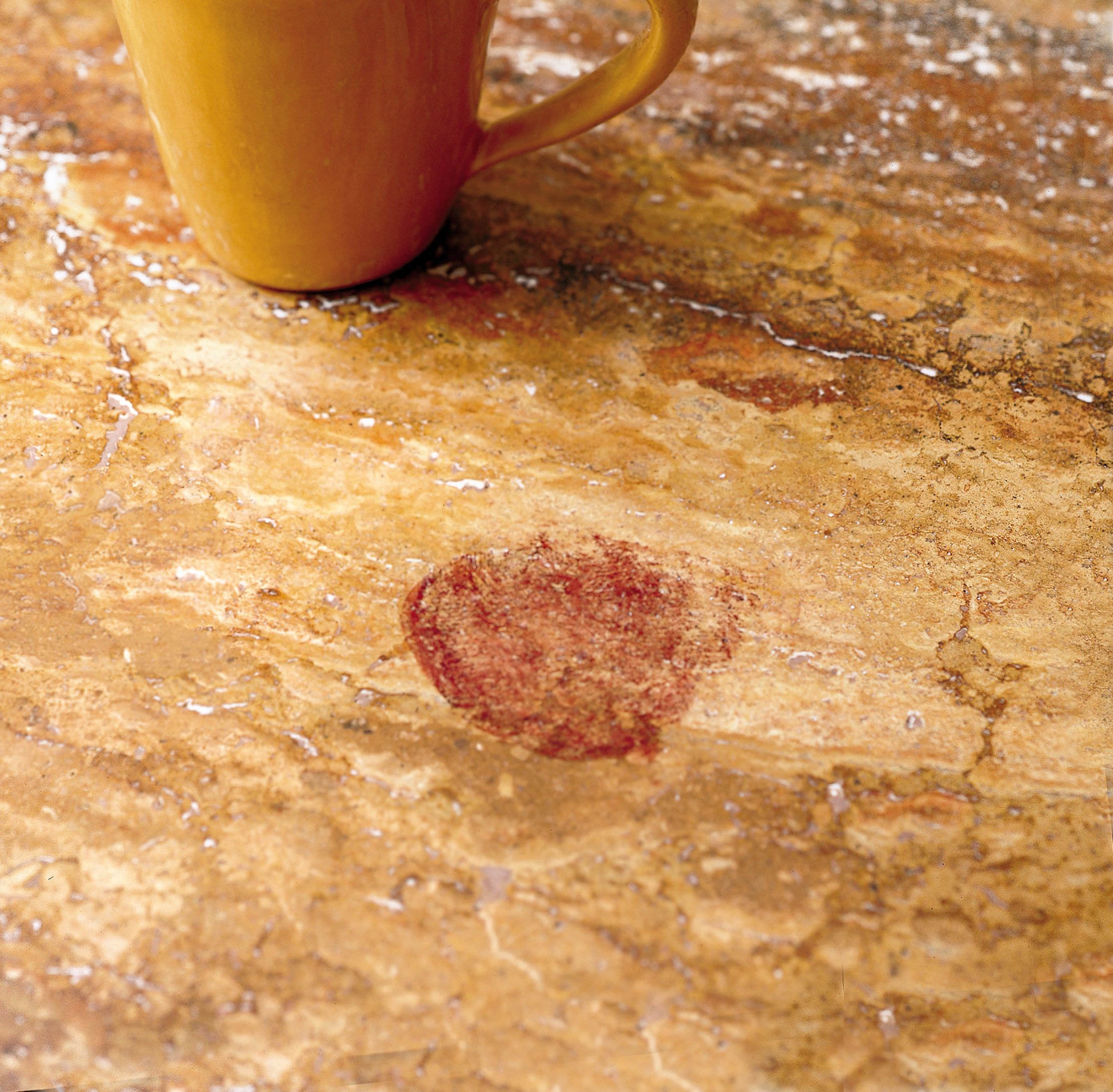Project details
Skill
Cost
Estimated Time
Kitchen countertops are the workhorses of our homes, enduring spills, splatters, and accidents on a daily basis. Despite our best efforts, stains happen.
But with the right knowledge and techniques, most stains can be removed. This guide will walk you through the process of identifying, treating, and preventing stains on various countertop materials so that your kitchen remains functional and beautiful.
Understanding Different Countertop Materials
The method you use to clean your countertops is dependent on your counter’s material. Different materials require specific cleaning methods to avoid damage while effectively removing stains. Let’s explore the characteristics of common countertop materials and their stain-resistance properties.
Natural Stone Countertops
Natural stone countertops, such as granite, marble, and limestone, are popular for their one-of-a-kind beauty and durability. However, they’re also porous and can be susceptible to staining if not properly sealed. When sealed properly, most spills can be wiped away before they have a chance to penetrate the surface. If a stain does occur, it’s important to use cleaning methods that won’t damage the stone’s surface.
Laminate Countertops
Laminate countertops are budget-friendly and come in a wide range of colors and patterns. Due to their non-porous surface, they’re generally resistant to staining. However, they can be susceptible to scratches and burns, which can make the surface more vulnerable to staining over time.
Most stains on laminate can be removed with mild soap and water or a specialized laminate cleaner. For tougher stains, a paste made from baking soda and water can be effective. It’s important to avoid abrasive cleaners or scrubbers that could damage the laminate’s surface.
Quartz and Engineered Stone Countertops
Quartz and other engineered stone countertops are nonporous and highly resistant to staining. These materials are made from crushed quartz mixed with resins and pigments, creating a durable and low-maintenance surface. While they’re highly resistant to stains, they aren’t completely stain-proof.
Most stains on quartz can be removed with warm water and mild soap. For tougher stains, a non-abrasive cleaner specifically designed for quartz can be used. Avoid harsh chemicals or abrasive materials that could damage the surface’s finish.
Common Types of Countertop Stains
Different countertop stains require different treatment methods. Here are some of the most common types of stains you might encounter on your kitchen countertops.
Food and Beverage Stains
Food and beverage stains are common in kitchens. These can include coffee, tea, wine, fruit juices, and food coloring. On porous surfaces like natural stone, these stains can penetrate quickly if not cleaned promptly. For non-porous surfaces like quartz or laminate, these stains typically remain on the surface and are easier to clean.
Oil and Grease Stains
Oil and grease stains can be particularly troublesome, especially on porous surfaces. These stains can come from cooking oils, butter, or fatty foods. They tend to darken the surface of the countertop and can be difficult to remove if allowed to set.
Chemical and Cleaning Product Stains
Chemical stains can occur from household cleaners, beauty products, or other substances containing harsh chemicals. These stains can be particularly damaging as they may etch or discolor the surface in addition to leaving a stain. Always use caution when using chemical products near your countertops, and clean up spills immediately.
Essential Tools and Materials for Countertop Stain Removal
Having the right tools and materials on hand can make the stain-removal process much easier and more effective. Here’s what you’ll need to tackle most countertop stains:
- Mild dish soap
- White vinegar
- Baking soda
- Hydrogen peroxide
- Specialized stone or quartz cleaners
- Soft cloths or microfiber towels
- Plastic putty knife
- Soft-bristled brush
- Spray bottle
- Rubber gloves
- Safety goggles (for working with chemicals)
- Plastic wrap (for poultice method)
Step-by-Step Countertop Stain Removal Techniques
Removing stains from your countertops requires a systematic approach. Follow these steps to effectively treat most stains without damaging your countertop surface.
Step 1: Prepare the Work Area
Start by clearing the countertop of any items and thoroughly cleaning it with mild soap and water. This will help you identify the exact location and extent of the stain.
Step 2: Identify the Stain Type
Examine the stain to determine its nature. Is it an oil-based stain, a water-based food stain, or a chemical stain? The type of stain will guide your choice of cleaning method.
Step 3: Start With the Mildest Cleaning Method
For most stains on non-porous surfaces, start with the mildest cleaning method and progress to stronger methods if needed. For porous surfaces like natural stone, a poultice may be necessary for deep-set stains.
Using a Poultice on a Kitchen Countertop Stain
Stubborn countertop stains can often be effectively treated with a poultice, a paste that draws out the stain from the surface. This method is especially useful for porous surfaces like natural stone. This section provides detailed steps on how to use a poultice, including covering the treated area to slow the drying process and thoroughly rinsing and drying the surface afterward.
Step 1: Prepare the Poultice
Mix flour and hydrogen peroxide to create a poultice that’s about the consistency of creamy peanut butter. Peroxide works best for food stains, but in the case of cooking oil stains, you can sub in dishwashing liquid, which breaks up the oil. For biological stains — mold, mildew, fungus — consider household bleach. Test the poultice on an inconspicuous spot on the countertop before applying it to the stain.
Step 2: Apply the Poultice
Applying the poultice is something like icing a cake. Using a plastic putty knife, spread a quarter-inch layer of the paste over the stain and beyond it by a quarter of an inch or more. The older and darker the stain, the longer you’ll need to leave the poultice in place and the greater the likelihood you’ll need to repeat the process.
If the stain is less than a day old, a single application may work in 10 hours, but for most stains you should wait 24 hours just to be safe.
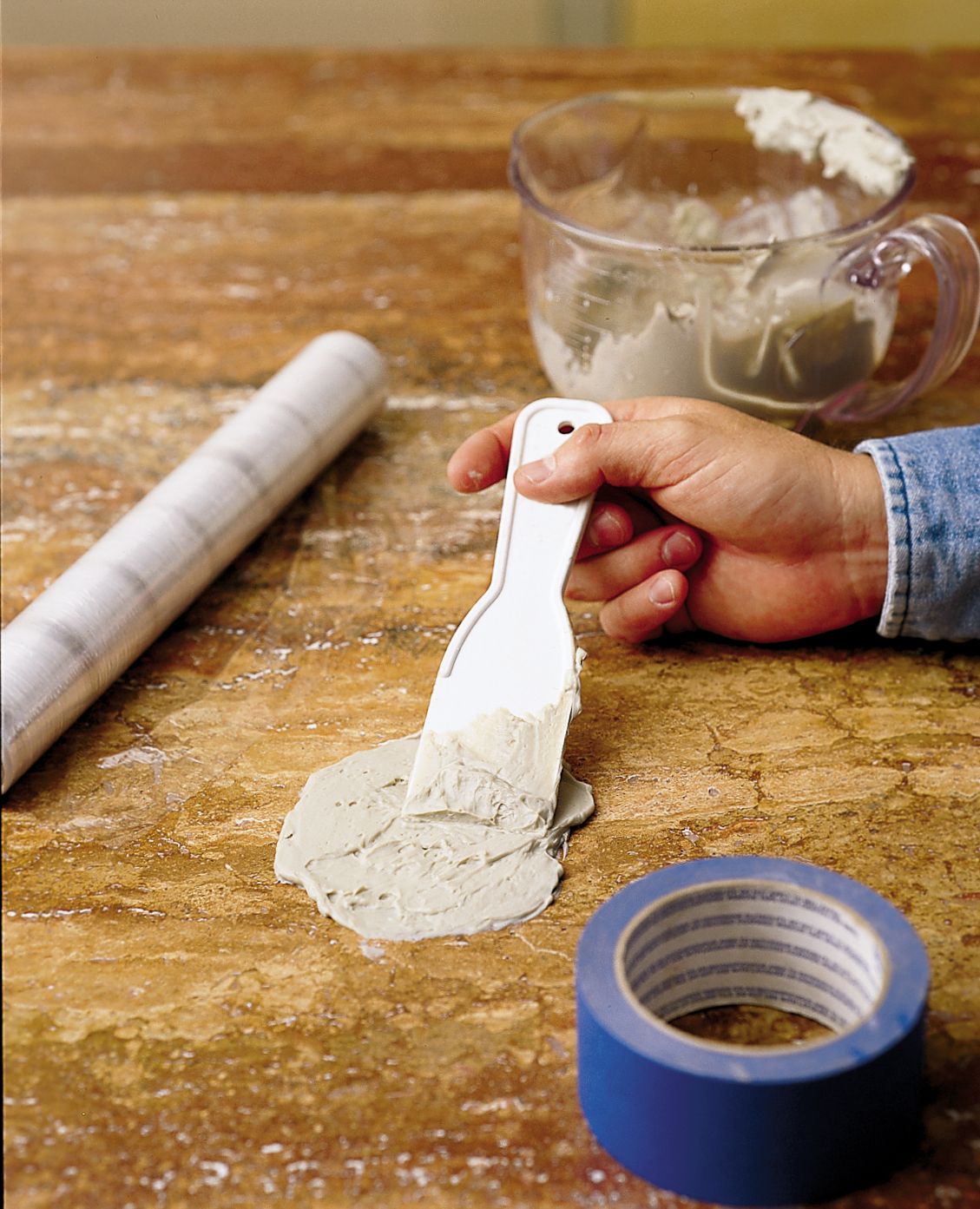
Step 3: Cover the Treated Area
Covering the wet poultice with a sheet of plastic wrap slows the drying process of the active chemical. When the poultice is dry, remove the tape and plastic.
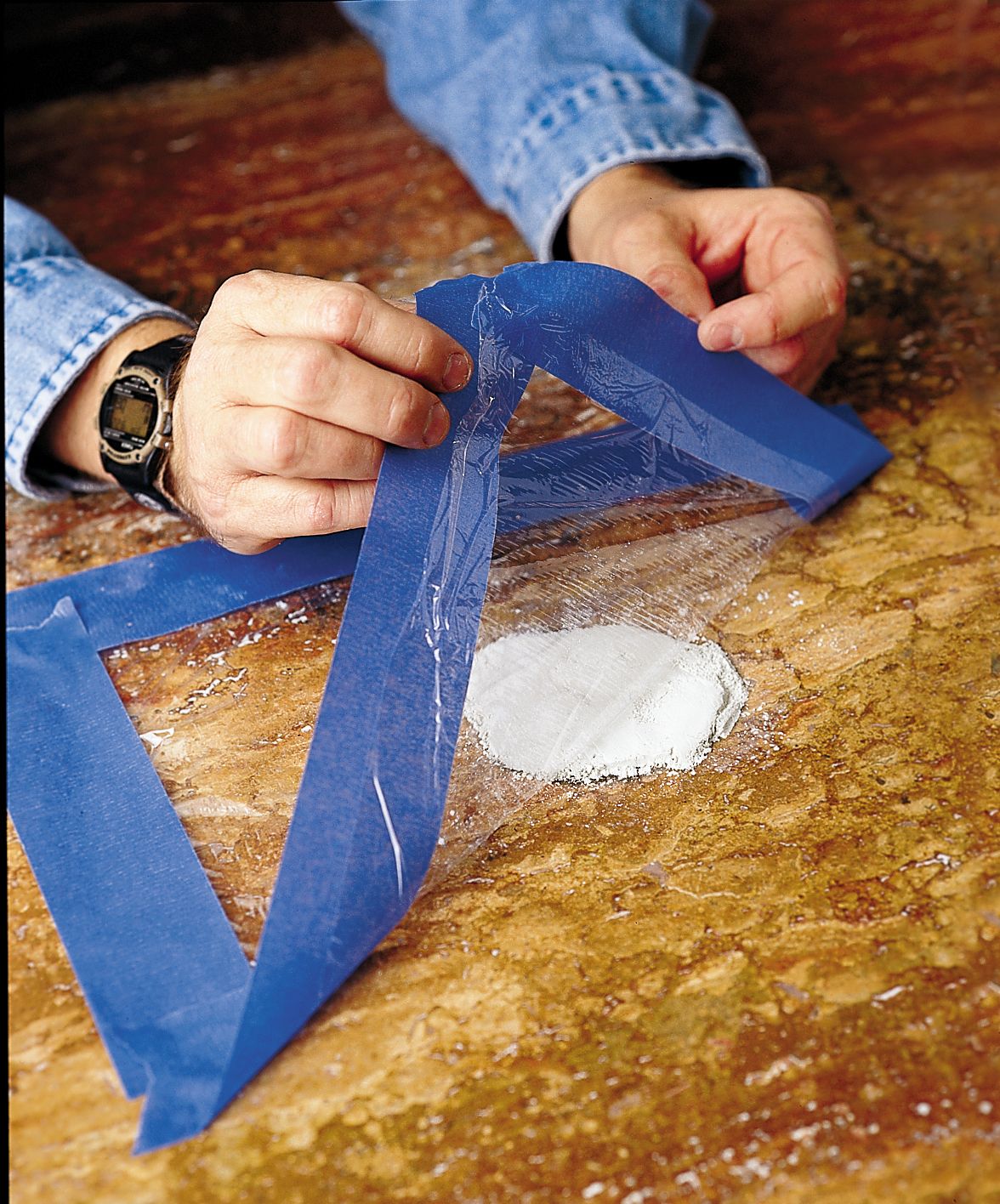
Step 4: Rinse and Dry the Surface
After treating the stain, thoroughly rinse the area with clean water and dry it with a soft cloth. This will help you assess whether the stain has been fully removed or if further treatment is needed.
Other DIY Kitchen Countertop Stain Removal Solutions
Many stains can be effectively treated with simple, do-it-yourself (DIY) solutions. Here are some methods you can try at home.
Vinegar and Baking Soda Method
For light stains on non-porous surfaces, create a paste with baking soda and water. Apply it to the stain, let it sit for a few minutes, and then wipe clean with a damp cloth. For tougher stains, add a small amount of white vinegar to create a fizzing action that helps lift the stain.
Commercial Stain Removers
For particularly stubborn stains, commercial stain removers designed for your specific countertop material can be effective. Always follow the manufacturer’s instructions and test the product on an inconspicuous area first.
Preventing Future Stains on Kitchen Countertops
Prevention is key to maintaining the beauty of your kitchen countertops. Here are some tips to help prevent future stains.
Proper Sealing Techniques
Regular sealing is crucial for natural stone countertops. Sealers should be reapplied at least once annually to create a barrier that prevents liquids from penetrating the stone’s surface.
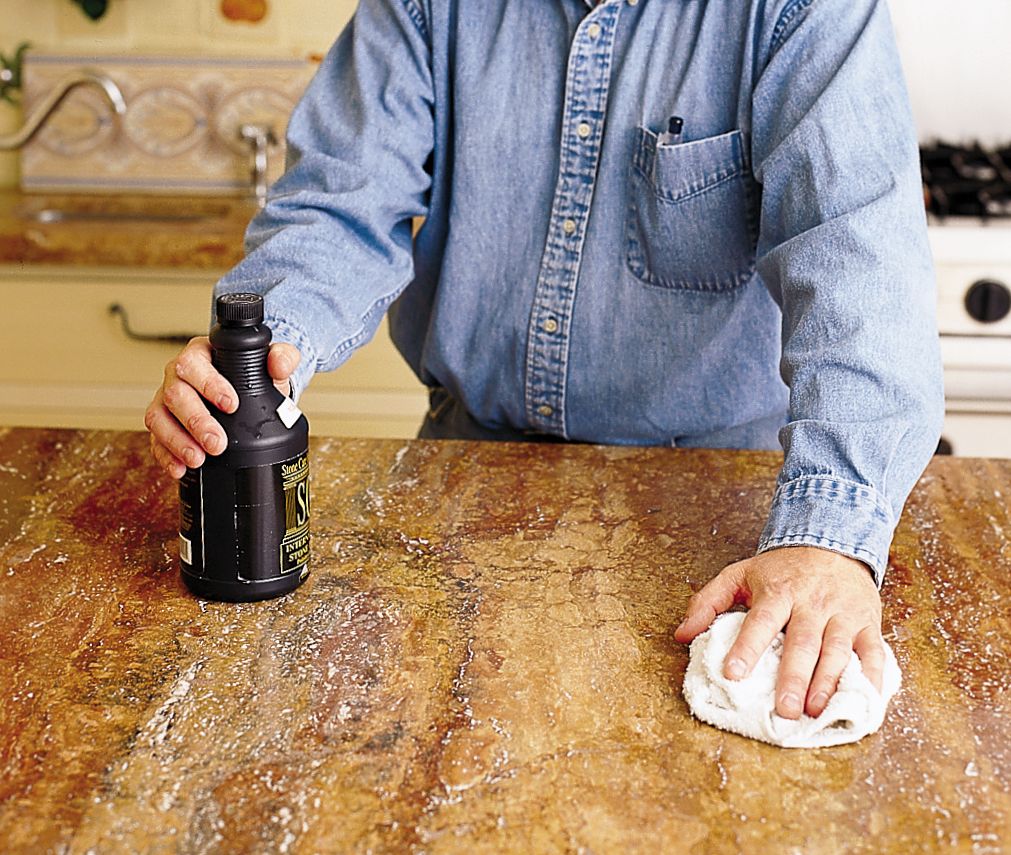
Daily Maintenance Tips
Wipe up spills immediately, especially on porous surfaces. Use coasters under glasses and trivets under hot dishes to prevent water rings and heat damage. Clean your countertops daily with a mild soap and water solution.
Using Protective Surfaces
Consider using cutting boards, placemats, and trivets to protect your countertops from potential stains and damage. This is especially important for wood countertops, which can be more susceptible to staining and scratching.
When To Call a Professional to Remove a Countertop Stain
While many stains can be treated at home, there are times when professional help may be necessary. If you’ve tried multiple methods and the stain persists, it may be time to call in a pro. They have access to specialized products and techniques that can tackle even the toughest stains.
If your stone countertop has been etched by acidic substances or otherwise damaged, professional restoration may be needed. The stone will likely need a new sealer and polishing.
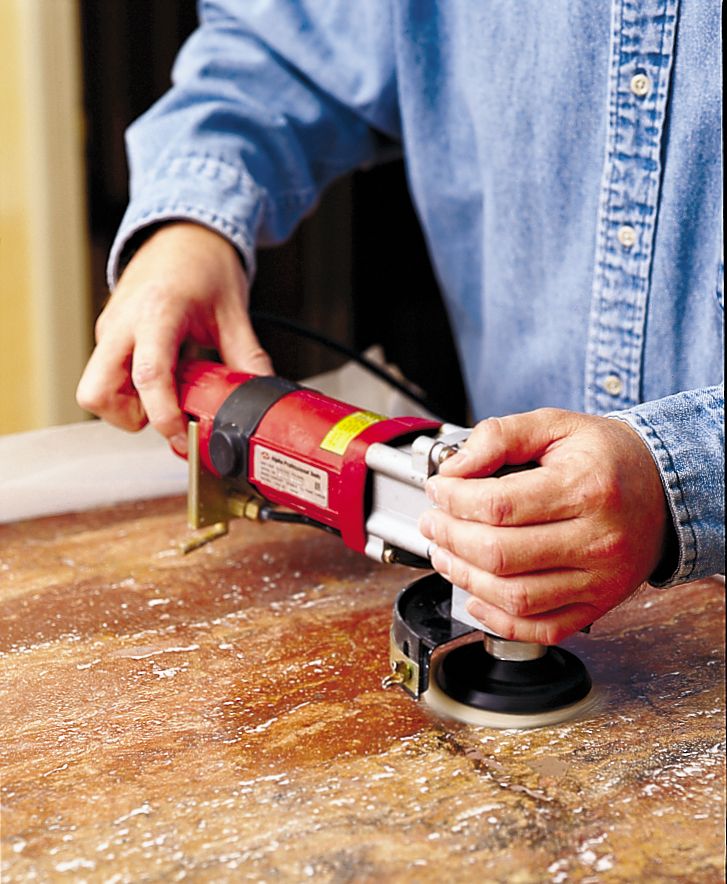
Our Conclusion
Removing stains from kitchen countertops can be a straightforward process with the right knowledge and techniques, but prevention is always better than a cure. Regular cleaning, prompt attention to spills, and proper sealing of porous surfaces can go a long way toward keeping your countertops stain-free. When in doubt, don’t hesitate to consult with a professional to ensure the longevity and appearance of your kitchen countertops.
